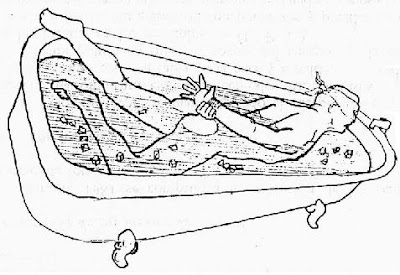How to Do an Ice Bath
In a recent post, I discussed 5 ways of treating muscle soreness. One of them suggested ice baths as a valid way of not only treating, but preventing muscle soreness from workouts. Jenny, one of my students who is a doctor, the one who hasn’t faltered in her attemts to get me onto the ice bath regime, read my blog post and sent me a few methods for doing ice baths. I’ll post them here.
This one comes from an article from Runner’s World:
“First you have to get ready. Prepare your post work out recovery smoothie, protein drink or recovery bar, set it next to the bath. Collect reading material.“Overcome pain” would be a good choice, the latest edition of “Runner’s World” or “The Ultimate Fighter” works too. Undress. Put on a woolly hat, woolly scarf and mitts. Step into the empty bath. Turn on the taps for a lukewarm flow of water and sit. Once there is an inch of lukewarm water covering the bottom of the bath, turn off the hot tap and just let the cold water fill up the remainder of the bath to cover the legs completely, higher if you also did a hard abdominal muscle work out or arm training. Screech, shiver and curse a few times. The cold water is usually cold enough, but for the masochist reader, you can add ice cubes once the body is covered. Make sure you keep your hands dry. Wait two minutes. The shivering usually stops and you can reach over, grab the food and book, sit back, relax and enjoy for 15 minutes. Dream of future glory. No sane competitor will be doing this: You are the champion.”
And here is the method that Jenny uses herself from an article written by physical therapist and runner Nikki Kimball:
“Over the years, I’ve discovered tricks to make the ice bath experience more tolerable. First, I fill my tub with two to three bags of crushed ice. Then I add cold water to a height that will cover me nearly to my waist when I sit in the tub. Before getting in, I put on a down jacket and a hat and neoprene booties, make myself a cup of hot tea, and collect some entertaining reading material to help the next 15 to 20 minutes pass quickly.
Though scientific research exists to support the use of ice baths to promote recovery, no exact protocol has been proven better than others. In general, water temperatures should be between 50 to 59 degrees Fahrenheit, and immersion time should ranges from 10 to 20 minutes. Among top runners, I see ice bath techniques that vary within and on either side of these ranges. My favorite method is the post-race soak in a cold river or lake with fellow competitors.”
Or if you’re like me, you might have to get a friend to assist you and use the method as applied in torture sessions by certain military dictatorships as depicted in the following image:


 We're proud to announce that Lori O'Connell Sensei's new book, When the Fight Goes to the Ground: Jiu-jitsu Strategies & Tactics for Self-Defense, published through international martial arts publisher Tuttle Publishing, is now available in major book stores and online. More about it & where to buy it.
We're proud to announce that Lori O'Connell Sensei's new book, When the Fight Goes to the Ground: Jiu-jitsu Strategies & Tactics for Self-Defense, published through international martial arts publisher Tuttle Publishing, is now available in major book stores and online. More about it & where to buy it.